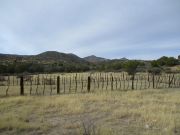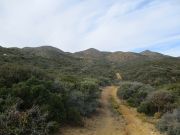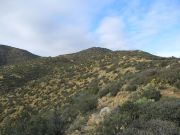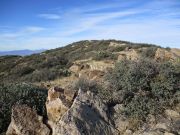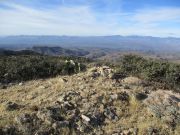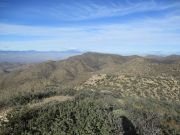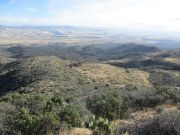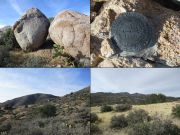
The Mountains of Arizona
• www.surgent.net
|
| Aquarius Mountain |
• Highpoint: Aquarius Mountains • Bureau of Land Management • Mohave County |
|
Date: December 2, 2022
• Elevation: 6,236 feet
• Prominence: 1,496 feet
• Distance: 5.8 miles
• Time: 3 hours & 45 minutes
• Gain: 1,550 feet
• Conditions: Cool with high clouds, periods of sun
Arizona
•
Main
•
AZ P1K
•
PB
•
LoJ
The Aquarius Mountains rise east of highway US-93, north and east of the town of Wikieup, in Mohave county about 60 miles southeast of Kingman. The highest peak does not have a name, going by just "Aquarius Mountains Highpoint". I shorten it to Aquarius Mountain here. This is one of those peaks that was never on my radar, being a long drive from home and (I assumed) with uncertain access. To be honest, I had never done any homework on this peak, other than I was aware it existed.
I saw a short summary from a climber at the HikeArizona site, with some images, and just enough information to prompt me to take another look at this peak. For one thing, the peak lies on BLM property which meant access would not be barred. Most of this area is private and State Trust, which is why I assumed access may be difficult. But the peak lies within a large swath of BLM land, it turns out. It looked friendly. So I lit a fire under my butt and made it a point to go visit it.
A storm was due in the state over the weekend so I bumped up my hike by a day, being a Friday. I wanted, as usual, to be at the trailhead as close to sun-up as possible. The trailhead was an 180-mile drive, so I was on the road at 3:15 a.m., following the usual route through Wickenburg to Wikieup. Other than big trucks, there was essentially zero traffic on the highways.
I rolled into Wikieup a shade before 6 a.m., with dawn still an hour away. So I pulled into a Mobil station, parked off to the side and had a nap. I also went in for snacks and talked with the night guy, who seemed bored. At about 6:45, I got back on the road, drove north a dozen miles and exited onto the Lower Trout Creek Road. This is a good road that leads into the Aquarius Mountains, up and over the range down into a big elevated valley east of the range. It was still dark as I started driving these roads, but the sun was just starting to rise, offering a tiny amount of light.
Lower Trout Creek Road connects to Bogles Ranch Road in a couple miles, all these roads being wide graded dirt roads. On Bogles Ranch Road, there are mile markers, starting at 20 and counting downward (mile marker 0 appears to be at a locale called Cedar Basin Camp, which I think is an outstation of the O-RO Ranch, all this area being within its unofficial fiefdom). The road ascends nearly 3,200 vertical feet into the hills, and by the time I reached its apex and started down into the valley, it was light now, and I just kept to the main road, following the mileage markers. The side road I wanted was between marker 3 and 2, closer to 2. The entire road to here was fine, just one or two bumpy spots toward the end. On this lesser side track now, I followed it in about a quarter mile to a gate and corral. This side road was choppy, but not difficult. I parked beside the gate and got myself properly attired and packed. I started my walk at 7:50 a.m., the sky mostly high thin clouds muting the light, the temperature in the 40s. There was no breeze. Everything was still and quiet.
The gate is kept closed by a chain but not locked, no signs saying get lost. Beyond the gate, I walked the road. It bends northwest and enters a drainage, the main one coming off the highest peaks. The road could be driven but would need 4-wheel drive, probably better suited for an ATV. It runs a mile and a half, ending at a turn-around at the lip of the main drainage channel. The road was helpful in that it covered half the distance quickly and gained about 400 feet, too. I could see the high peaks well now and gain a sense of where to go and what I wanted to do.
I dropped into the drainage, which is extremely brushy at first. There were actual trees here, mainly gambel oak, and a few lovely cottonwoods with yellow leaves, contrasting against the darker green brush. In fact, once higher up, I could look back down and still see these cottonwoods, as they really stood out visually. On the other side of the drainage, I found narrow open paths through manzanita which ran about 200 feet, then dropped back into the channel, which was more open. It was rocky but not bad, and I was able to make decent time in it. I followed it for a quarter mile or so until I had a clear view of the peak again. When it felt right, I ascended out of the canyon and up the slope. I used my new favorite old fashioned trick of navigation and tied orange surveyor tape to strategic branches for my return hike. There wasn't any concern about getting lost; I just wanted to retrace my route and avoid unnecessary brush on the way down.
The uphill hike was steep and a little loose, but I gained 400 feet quickly, the brush being open and easy to weave through. This put me on top of the main east ridge that emanates off the highpoint peak. By now, I had a good sense of what was above me: the main highpoint peak directly ahead, a rounded subpeak "Bonner Benchmark" to my left (south) and a pointed peak whose elevation was about 10 feet lower than the highpoint, to my right (north).
The ridge was fantastic. It was pitched gently, and there was always some way through the brush. The brush was about knee high, consisting of woody manzanita and holly, low cactus like pencil cholla and prickly pear, and low grasses and shrubs. And there was always a path through, every single time. Who or what would have possibly gone through the trouble to bash paths through this crud? I saw brownish circular mounds of dried poo in a few spots. Suddenly, I knew.
The final slope up was moderately steep but not difficult at all. It gained about 350 feet, aiming toward a small rock outcrop. Once I got to it, I saw another low mound of rocks up ahead, thinking that was the summit. It wasn't, but behind it was the top, just a simple rounded bare hump. This was a peak where you don't see the summit until the last fifty feet. It had taken me 2 hours exactly to get here.
The views from up here were good. The sun came out finally and I had good light for photos. The big ranges were shrouded in clouds. Mohon Peak rose northeast, puffy clouds blocking its summit. I could make out Mount Hope on the Baca Grant/O-RO Ranch outfit. To the west, the Hualapai Mountains were visible except for the highest peaks, which were clouded. It was breezy up here and very chilly too. The register didn't hold many names, going back to the early 1990s. Wade Luther was up here two weeks ago; it was his information at HikeArizona that I used as an excuse to come here. I spent fifteen minutes up top, having a snack and drink, but the chilly breeze motivated me to keep moving.
I hiked down the same route as I did coming up, the surveyor's tape helping me drop back into the drainage at the "right" spot. The outbound hike took me about 90 minutes, not including another 15-minute break I took about halfway out. I was hoping for better light for a particular image, so I just sat there, as an excuse to take a nice break. There was no reason to hurry. It was about this time when I heard some branches breaking and general scampering. On the hilside opposite me was a small herd of about a dozen cows (a bull or two, plus some adolescents). They were mooving pretty good for being on such steep terrain. Cows continue to impress me by their ability to moove well on sloping loose terrain and bash in trails through the dense scrub. The light never did improve for my photograph, so I got back to walking back to my car, arriving at 11:40 a.m., just under a 4-hour hike.
This was a fun peak and I was pleasantly surprised how efficiently it all went. This is an area I rarely get to, my last time here being when I hiked Mohon Peak in 2016. And before then, in 2011, scouting a way to Mohon Peak. I just assumed that the peaks back here were on private land and/or choked with brush. I am glad I came here today, thanks to those who came before me to prompt me to actually look at this peak in a different light.
The drive home was not exciting. There was lots more traffic now, moderately heavy southbound into Wickenburg, but very heavy northbound to Las Vegas. I took the scenic route from Wickenburg, south on Vulture Mine Road into Tonopah and catching Interstate-10 from there. On these backroads, there were a number of motorcyclists out for the ride. This Wickenburg-Tonopah route is always open with no traffic. Enjoy it now until Interstate-11 is routed through here in the future.
I was back "home" about 4ish, just in time for Friday traffic. I had been gone for 13 hours, covered almost 400 miles, and hiked a really cool peak in the Arizona hinterlands. This peak was a real treat and I enjoyed it very much. I had a bit of good news come my way two days previously and this was a little gift to myself, to go out and hike a nifty peak.
|
|
